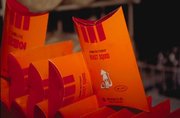Squid
|
|
| Squid | ||||||||||||
|---|---|---|---|---|---|---|---|---|---|---|---|---|
 Clipart provided by Classroom Clip Art (http://classroomclipart.com) | ||||||||||||
| Scientific classification | ||||||||||||
| ||||||||||||
| Suborders | ||||||||||||
Squids are the large, diverse group of marine mollusks, popular as food in cuisines as widely separated as the Korean and the Italian. In fish markets and restaurants in English-speaking countries, it is often known by the name calamari, from the Italian word for these animals.
Squids are members of the class Cephalopoda, subclass Coleoidea, order Teuthida, of which there are two major suborders, Myopsina and Oegopsina (including the giant squids like Architeuthis dux). Teuthida is the largest of the cephalopod orders, edging out the octopuses (order Octopoda) for total number of species, with 298 classified into 28 families.
The order Teuthida is a member of the superorder Decapodiformes (from the Greek for "ten legs"). Two other orders of decapodiform cephalopods are also called squid, although they are taxonomically distinct from Teuthida and differ recognizably in their gross anatomical features. They are the bobtail squids of order Sepiolida and the Ram's Horn Squid of the single species order Spirulida. The Vampire Squid, however, is more closely related to the octopuses than to any of the squids.
Like all cephalopods, squids are distinguished by having a distinct head, bilateral symmetry and tentacles with suckers; squid, like cuttlefish, have eight arms and two tentacles arranged in pairs. Squids can blend in with their surroundings to avoid predators. They also have chromatophores embedded in their skin and the ability to expel ink if threatened. Being coleoids means that their bony structure is internalized (in the octopus it is nonexistent); in squid there is a single flat bone plate buried within the soft tissue structure. They have a specialized foot called the siphon, or hyponome, that enables them to move by expelling water under pressure. Squid are the most skilled of the coleoids at this form of motion. The mouth of the squid is equipped with a sharp horny beak made of chitin, used to kill and tear prey into manageable pieces. Captured whales often have squid beaks in their stomachs, the beak being the only indigestible part of the squid. The mouth contains the radula (the rough tongue common to all molluscs except bivalvia and aplacophora).
Squid have two gills and an extensive closed circulatory system consisting of a systemic heart and two gill hearts.
They are exclusively carnivorous, feeding on fish and other invertebrates. Squid usually have two elongated tentacles especially for the capture of food.
The majority of squid are no more than 60 cm in length, but the giant squid is reportedly up to 20 m in length, which made it the largest invertebrate in the world, and it has the largest eyes of all. Recently, however, an even larger specimen of a poorly understood species, Mesonychoteuthis hamiltoni (the Colossal Squid) has been discovered. Giant squids are featured in literature and folklore, with a strongly frightening connotation.
Individual species of squid are found abundantly in certain areas and provide large catches for fisheries.
Classification
Iwami_squid_drying_DSC01868.jpg
- CLASS CEPHALOPODA
- Subclass Nautiloidea: nautilus
- Subclass Coleoidea: squid, octopus, cuttlefish
- Superorder Decapodiformes
- Order Spirulida: Ram's Horn Squid
- Order Sepiida: cuttlefish
- Order Sepiolida: bobtail squid
- Order Teuthida: squid
- Suborder Myopsina
- Family Loliginidae: inshore, calamari, and grass squid
- Suborder Oegopsina
- Family Ancistrocheiridae: Sharpear Enope Squid
- Family Architeuthidae: giant squid
- Family Bathyteuthidae
- Family Batoteuthidae: Bush-club Squid
- Family Brachioteuthidae
- Family Chiroteuthidae
- Family Chtenopterygidae: comb-finned squid
- Family Cranchiidae: glass squid
- Family Cycloteuthidae
- Family Enoploteuthidae
- Family Gonatidae: armhook squid
- Family Histioteuthidae: jewel squid
- Family Joubiniteuthidae: Joubin's Squid
- Family Lepidoteuthidae: Grimaldi Scaled Squid
- Family Lycoteuthidae
- Family Magnapinnidae: Bigfin Squid
- Family Mastigoteuthidae: whip-lash squid
- Family Neoteuthidae
- Family Octopoteuthidae
- Family Ommastrephidae: flying squid
- Family Onychoteuthidae: hooked squid
- Family Pholidoteuthidae
- Family Promachoteuthidae
- Family Psychroteuthidae: Glacial Squid
- Family Pyroteuthidae: fire squid
- Family Thysanoteuthidae: rhomboid squid
- Family incertae sedis (uncertain group)
- Family Walvisteuthidae
- Suborder Myopsina
- Superorder Octopodiformes
- Superorder Decapodiformes

